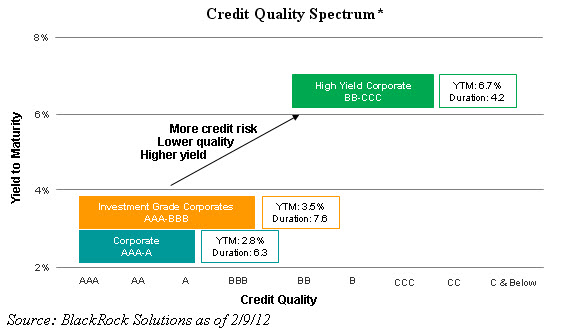First, the bad (and obvious) news: When it comes to investing, you can’t control returns. Now, the good news: You can manage the amount of risk in your portfolio, and managing risk is one way of influencing returns.
Take, for example, the investment grade corporate bond space, which consists of bonds rated AAA all the way down to BBB-. Until recently, most pooled investment vehicles such as ETFs and mutual funds offered investment grade access based on this typical definition. With last month’s launch of the iShares Aaa-A Rated Corporate Bond Fund (NYSE Arca: QLTA), investors now have a tool for targeting a specific amount of credit risk within their fixed income investments and, more specifically, can eliminate exposure to BBB-rated bonds.
Why would an investor want to slice and dice the corporate bond space using credit quality? I frequently speak with clients that have mandates that stipulate a minimum credit quality of A or higher for their bond portfolios. Just as many insurance companies and public unions have this requirement either by law or as a part of their investment policy statements, so do many individual investors feel generally uncomfortable with lower credit quality. For both groups, QLTA provides the ability to stay at the upper tier of the quality spectrum, while also offering diversified exposure across sectors and maturities.
Because of the reduced exposure to lower rated bonds, there is a tradeoff in yield vs. broader indices (see graph below). But the benefit of QLTA is that it allows investors to quantify what that tradeoff is worth.
We typically see clients using this in one of two ways. First, as a complement to their broad corporate bond exposure (for example, the iShares iBoxx $ Investment Grade Corporate Bond Fund; NYSE Arca: LQD). AAA to A bonds comprise about 71% of LQD, which means that 29% is BBB-rated bonds. Adding an allocation to QLTA can tilt overall exposure toward the higher quality end of the spectrum. And second, investors who are allocating their equity exposure to high quality companies can now take similar positioning in their fixed income portfolio.
* Index data for High Yield, Investment Grade Corporate and Corporate AAA-A. These are iBoxx $ Liquid High Yield Index, iBoxx $ Liquid Investment Grade Index and the Barclays Capital US Corporate Aaa – A Capped Index. Index constituents are subject to change.
Index returns are for illustrative purposes only and do not represent actual iShares Fund performance. Index performance returns do not reflect any management fees, transaction costs or expenses. Indexes are unmanaged and one cannot invest directly in an index. Past performance does not guarantee future results. For actual iShares Fund performance, please visit www.iShares.com
Bonds and bond funds will decrease in value as interest rates rise. In addition to the normal risks associated with investing, narrowly focused investments typically exhibit higher volatility. The Funds are subject to credit risk, which refers to the possibility that the debt issuers may not be able to make principal and interest payments or may have their debt downgraded by ratings agencies. High yield securities may be more volatile, be subject to greater levels of credit or default risk, and may be less liquid and more difficult to sell at an advantageous time or price to value than higher-rated securities of similar maturity. Diversification may not protect against market risk.











